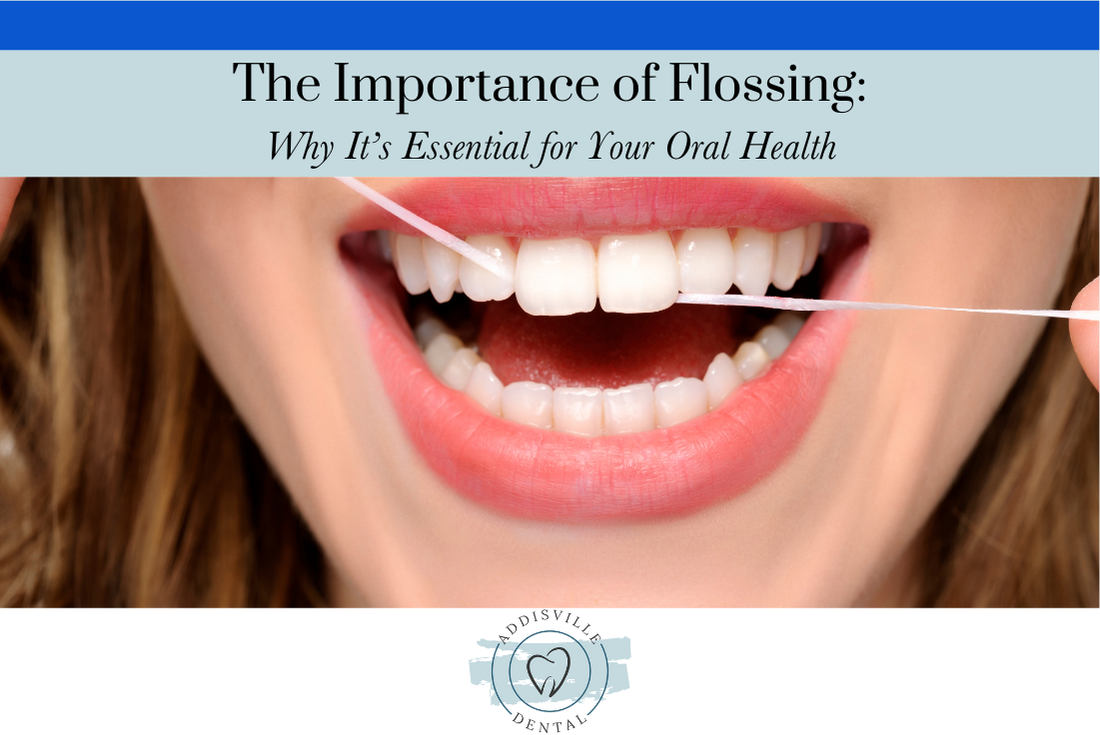
At Addisville Dental, we emphasize the importance of flossing as part of a complete oral care routine. In this blog, we will explore why flossing is essential, how it benefits your oral and overall health, and how to do it correctly to maximize its benefits.
Why Is Flossing So Important?
Flossing removes plaque, food particles, and bacteria from areas that a toothbrush cannot reach. Without flossing, these particles accumulate and contribute to serious dental issues, including:
1. Prevention of Cavities
Plaque buildup between the teeth can lead to tooth decay. Flossing removes plaque from these hard-to-reach areas, preventing cavities from forming between the teeth.
2. Gum Disease Prevention
When plaque is not removed, it hardens into tartar, leading to gingivitis—the first stage of gum disease. Gingivitis can cause red, swollen gums that bleed when brushing or flossing. If left untreated, it can progress to periodontitis, a more severe form of gum disease that can lead to tooth loss.
3. Freshens Breath
Trapped food particles and bacteria between the teeth contribute to bad breath. Flossing helps remove these hidden culprits, keeping your breath fresher for longer.
4. Reduces the Risk of Systemic Health Issues
Studies have linked gum disease to serious health conditions, such as heart disease, diabetes, and respiratory infections. Flossing helps reduce the bacteria in your mouth that can enter your bloodstream and negatively impact your overall health.
5. Prevents Plaque Buildup and Staining
Flossing helps prevent the accumulation of plaque, which can lead to unsightly stains and a dull smile. Keeping your teeth free of plaque allows your smile to look brighter and healthier.
How to Floss Correctly
Flossing properly ensures you get the maximum benefits. Follow these simple steps to floss effectively:
- Choose the Right Floss
- Traditional waxed or unwaxed floss works well for most people.
- If you have braces or dental work, specialized floss like dental tape or floss threaders may be needed.
- Use Enough Floss
- Cut about 18 inches of floss and wrap the majority of it around your middle fingers, leaving about 1-2 inches to work with.
- Glide, Don’t Snap
- Gently slide the floss between your teeth using a back-and-forth motion. Avoid snapping it down, as this can irritate or damage your gums.
- Curve Around the Tooth
- Form a C-shape around the base of each tooth, sliding the floss just beneath the gumline.
- Use a Clean Section
- As you move from tooth to tooth, use a fresh section of floss to avoid redistributing plaque and bacteria.
- Don’t Forget the Back Teeth
- Make sure to floss behind the last molars, as these areas are often neglected but still collect plaque and bacteria.
Alternative Ways to Clean Between Teeth
For those who find traditional flossing difficult, there are alternative tools that can help maintain interdental cleanliness:
- Floss Picks: Convenient for on-the-go use, though they may not be as effective as traditional floss.
- Water Flossers: Ideal for individuals with braces, dental implants, or sensitivity issues.
- Interdental Brushes: Small brushes designed to fit between teeth, great for people with larger gaps.
How Often Should You Floss?
The American Dental Association (ADA) recommends flossing at least once per day to maintain good oral health. The best time to floss is before bed to ensure your teeth are free of plaque and food debris overnight.
Frequently Asked Questions About Flossing
Q: Is it better to floss before or after brushing?
A: It is generally recommended to floss before brushing. Flossing first removes plaque and debris, allowing fluoride from your toothpaste to better reach between your teeth for added protection.
Q: Can flossing too much hurt my gums?
A: Flossing too aggressively or too often (multiple times a day) can cause irritation and damage to the gum tissue. However, flossing once per day with the right technique should not cause harm.
Q: What if my gums bleed when I floss?
A: Bleeding gums can be a sign of inflammation or gingivitis. If you floss regularly, the bleeding should stop within a few days. If it persists, consult with your dentist at Addisville Dental to check for underlying issues.
Q: Can I use mouthwash instead of flossing?
A: While mouthwash helps kill bacteria and freshen breath, it does not remove plaque and food particles stuck between teeth. Flossing is still necessary for complete oral hygiene.
Q: What happens if I never floss?
A: Neglecting to floss increases your risk of cavities, gum disease, bad breath, and even systemic health problems like heart disease. Over time, you may experience gum recession and tooth loss.
Q: What type of floss is best?
A: The best floss is the one you will use consistently. Whether waxed, unwaxed, tape-style, or water flossers, choose the method that works best for your comfort and dental needs.
Q: How can I make flossing a habit?
A: Set reminders, keep floss in visible places (like next to your toothbrush), and try different flossing tools to find what works best for you. Making flossing part of your nighttime routine helps reinforce the habit.
Schedule Your Next Dental Visit at Addisville Dental!
Flossing is a simple yet powerful step in protecting your smile and overall health. At Addisville Dental, we are committed to helping our patients maintain excellent oral hygiene and prevent dental problems before they start.
If you have any concerns about flossing, gum health, or general oral care, schedule an appointment with our experienced dental team today!
📍 Visit Us:
📍 Address: 928 2nd St. Pike, Unit 4, Richboro, PA 18954
📞 Phone: (215) 485-5151
🌐 Website: addisvilledental.com
📅 Schedule Your Appointment Today!
Let’s work together to keep your smile healthy and bright for years to come! 🦷✨



